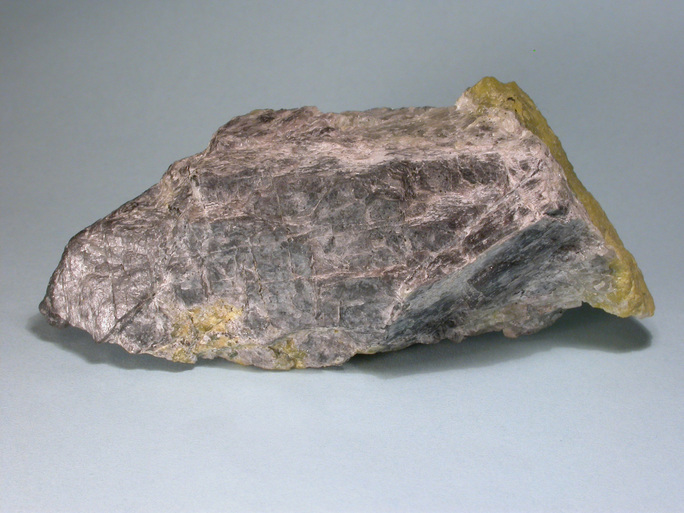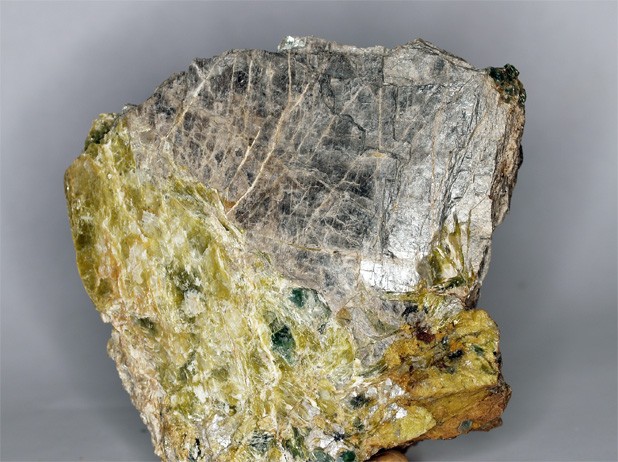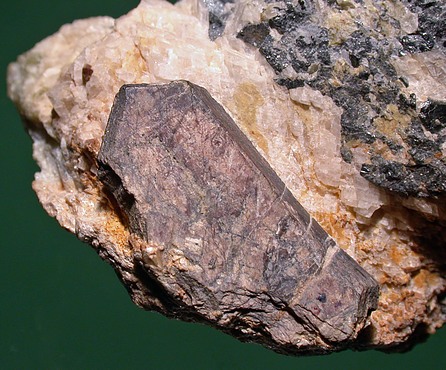Althausite
A valid IMA mineral species
This page is currently not sponsored. Click here to sponsor this page.
About Althausite
Formula:
Mg4(PO4)2(OH,O)(F,◻)
Colour:
Pale gray, reddish brown; dark blue, green, black
Lustre:
Sub-Vitreous, Resinous
Hardness:
3½ - 4
Specific Gravity:
2.97
Crystal System:
Orthorhombic
Name:
Named in 1975 by Gunnar Raade and Magne Tysseland in honor of Prof. Egon Althaus (February 15, 1933-June 16, 2022), mineralogist at University of Karlsruhe, Germany.
Type Locality:
This rare magnesium phosphate was first described from serpentine-magnesite deposits in Modum, Buskerud, Norway. Later the mineral has also been found as a secondary product in granitic pegmatites, in Brazil. In pegmatites the colour of the mineral may vary from dark blue–green to black (Frost et al., 2014). It has also been been found in the Panasqueira Sn–W deposit.
Althausite may alter to apatite along the cleavage planes. This is especially typical for the althausite found at the Overntjern locality, Norway.
Althausite may alter to apatite along the cleavage planes. This is especially typical for the althausite found at the Overntjern locality, Norway.
Unique Identifiers
Mindat ID:
148
Long-form identifier:
mindat:1:1:148:5
GUID
(UUID V4):
(UUID V4):
c63561da-a7e1-409a-adbc-76e00299fe1b
IMA Classification of Althausite
Approved
Approval year:
1974
First published:
1975
Classification of Althausite
8.BB.25
8 : PHOSPHATES, ARSENATES, VANADATES
B : Phosphates, etc., with additional anions, without H2O
B : With only medium-sized cations, (OH, etc.):RO4 about 1:1
8 : PHOSPHATES, ARSENATES, VANADATES
B : Phosphates, etc., with additional anions, without H2O
B : With only medium-sized cations, (OH, etc.):RO4 about 1:1
41.6.5.1
41 : ANHYDROUS PHOSPHATES, ETC.CONTAINING HYDROXYL OR HALOGEN
6 : A2(XO4)Zq
41 : ANHYDROUS PHOSPHATES, ETC.CONTAINING HYDROXYL OR HALOGEN
6 : A2(XO4)Zq
19.3.16
19 : Phosphates
3 : Phosphates of Be and Mg
19 : Phosphates
3 : Phosphates of Be and Mg
Mineral Symbols
As of 2021 there are now IMA–CNMNC approved mineral symbols (abbreviations) for each mineral species, useful for tables and diagrams.
| Symbol | Source | Reference |
|---|---|---|
| Ahs | IMA–CNMNC | Warr, L.N. (2021). IMA–CNMNC approved mineral symbols. Mineralogical Magazine, 85(3), 291-320. doi:10.1180/mgm.2021.43 |
Physical Properties of Althausite
Sub-Vitreous, Resinous
Transparency:
Translucent
Colour:
Pale gray, reddish brown; dark blue, green, black
Comment:
turning brown on alteration to apatite
Hardness:
3½ - 4 on Mohs scale
Tenacity:
Brittle
Cleavage:
Perfect
{010} perfect ; distinct along {110}
{010} perfect ; distinct along {110}
Density:
2.97 g/cm3 (Measured) 2.91 g/cm3 (Calculated)
Optical Data of Althausite
Type:
Biaxial (+)
RI values:
nα = 1.588 nβ = 1.592 nγ = 1.598
2V:
Measured: 70° , Calculated: 80°
Birefringence:
0.010
Max Birefringence:
δ = 0.010

Image shows birefringence interference colour range (at 30µm thickness)
and does not take into account mineral colouration.
and does not take into account mineral colouration.
Surface Relief:
Moderate
Dispersion:
relatively strong
Optical Extinction:
Parallel
Pleochroism:
Non-pleochroic
Chemistry of Althausite
Mindat Formula:
Mg4(PO4)2(OH,O)(F,◻)
Chemical Analysis
Oxide wt%:
| 1 | 2 | |
|---|---|---|
| Al2O3 | 0.53 % | % |
| Fe2O3 | 1.37 % | % |
| MnO | 0.07 % | % |
| MgO | 45.38 % | 50.5 % |
| CaO | 4.50 % | % |
| Na2O | 0.22 % | % |
| P2O5 | 43.59 % | 44.4 % |
| SiO2 | 0.11 % | % |
| F | 2.86 % | 3.04 % |
| Cl | 0.19 % | % |
| H2O+ | 1.87 % | % |
| H2O- | 0.07 % | % |
| -O=F2 Cl2 | -1.24 % | % |
| FeO | % | 0.80 % |
| Total: | 99.52 % | 98.74 % |
Sample references:
| ID | Type | Locality | Reference | Notes |
|---|---|---|---|---|
| 1 | Type Specimen | Tingelstadtjern Quarry, Modum, Buskerud, Norway | Analyst: B. Bruun | |
| 2 | Overntjern Quarry, Overntjern, Modum, Buskerud, Norway | Microprobe analysis |
Crystallography of Althausite
Crystal System:
Orthorhombic
Class (H-M):
mmm (2/m 2/m 2/m) - Dipyramidal
Space Group:
Pnma
Setting:
Pnma
Cell Parameters:
a = 8.258(2) Å, b = 6.054(2) Å, c = 14.383(5) Å
Ratio:
a:b:c = 1.364 : 1 : 2.376
Unit Cell V:
719.06 ų (Calculated from Unit Cell)
Z:
8
Morphology:
Rare crude crystals are elongated along [001], flattened on {010}, showing {010}, {110}, {131}, to 3 cm; generally as cleavable masses.
Crystal Structure
Load
Unit Cell | Unit Cell Packed
2x2x2 | 3x3x3 | 4x4x4
Unit Cell | Unit Cell Packed
2x2x2 | 3x3x3 | 4x4x4
Show
Big Balls | Small Balls | Just Balls | Spacefill
Polyhedra Off | Si Polyhedra | All Polyhedra
Remove metal-metal sticks
Big Balls | Small Balls | Just Balls | Spacefill
Polyhedra Off | Si Polyhedra | All Polyhedra
Remove metal-metal sticks
Display Options
Black Background | White Background
Perspective On | Perspective Off
2D | Stereo | Red-Blue | Red-Cyan
Black Background | White Background
Perspective On | Perspective Off
2D | Stereo | Red-Blue | Red-Cyan
View
CIF File Best | x | y | z | a | b | c
CIF File Best | x | y | z | a | b | c
Rotation
Stop | Start
Stop | Start
Labels
Console Off | On | Grey | Yellow
Console Off | On | Grey | Yellow
Data courtesy of the American Mineralogist Crystal Structure Database. Click on an AMCSD ID to view structure
| ID | Species | Reference | Link | Year | Locality | Pressure (GPa) | Temp (K) |
|---|---|---|---|---|---|---|---|
| 0000784 | Althausite | Romming C, Raade G (1980) The crystal structure of althausite, Mg4(PO4)2(OH,O)(F, ) American Mineralogist 65 488-498 |  | 1980 | 0 | 293 |
CIF Raw Data - click here to close
X-Ray Powder Diffraction
Powder Diffraction Data:
| d-spacing | Intensity |
|---|---|
| 3.59 Å | (100) |
| 3.42 Å | (40) |
| 3.32 Å | (90) |
| 3.02 Å | (80) |
| 2.89 Å | (40) |
| 2.79 Å | (60) |
| 2.70 Å | (30) |
| 2.64 Å | (60) |
Comments:
29-869
Geological Environment
Paragenetic Mode(s):
| Paragenetic Mode | Earliest Age (Ga) |
|---|---|
| High-𝑇 alteration and/or metamorphism | |
| 31 : Thermally altered carbonate, phosphate, and iron formations | |
| Stage 4b: Highly evolved igneous rocks | >3.0 |
| 34 : Complex granite pegmatites | |
| Stage 5: Initiation of plate tectonics | <3.5-2.5 |
| 38 : Ophiolites |
Type Occurrence of Althausite
General Appearance of Type Material:
Cleavable masses and crude tabular crystals to 3 cm
Place of Conservation of Type Material:
Mineralogical-Geological Museum, Oslo University, Oslo, Norway, 21978, 22044, 22045.
Geological Setting of Type Material:
A serpentine-magnesite deposit
Associated Minerals at Type Locality:
Reference:
Raade, G., Tysseland, M. (1975) Althausite, a new mineral from Modum, Norway. Lithos: 8: 215-219
Synonyms of Althausite
Other Language Names for Althausite
Common Associates
Associated Minerals Based on Photo Data:
| 15 photos of Althausite associated with Apatite | Ca5(PO4)3(Cl/F/OH) |
| 14 photos of Althausite associated with Lizardite | Mg3(Si2O5)(OH)4 |
| 10 photos of Althausite associated with Hematite | Fe2O3 |
| 8 photos of Althausite associated with Holtedahlite | Mg2(PO4)(OH) |
| 8 photos of Althausite associated with Leuchtenbergite | Mg5Al(AlSi3O10)(OH)8 |
| 6 photos of Althausite associated with Chlorapatite | Ca5(PO4)3Cl |
| 6 photos of Althausite associated with Magnesite | MgCO3 |
| 6 photos of Althausite associated with Clinochlore | Mg5Al(AlSi3O10)(OH)8 |
| 5 photos of Althausite associated with Heneuite | CaMg5(CO3)(PO4)3(OH) |
| 5 photos of Althausite associated with Phosphoellenbergerite | (Mg,◻)2Mg12(PO4,PO3OH)6(PO3OH,CO3)2(OH)6 |
Related Minerals - Strunz-mindat Grouping
| 8.BB. | Tilasite | CaMg(AsO4)F |
| 8.BB.X | Arsenowagnerite | Mg2(AsO4)F |
| 8.BB. | Moabite | NiFe3+(PO4)O |
| 8.BB. | Karlditmarite | Cu9O4(PO4)2(SO4)2 |
| 8.BB. | Milkovoite | Cu4O(PO4)(AsO4) |
| 8.BB. | Paulgrothite | Cu9Fe3+O4(PO4)4Cl3 |
| 8.BB.05 | Amblygonite | LiAl(PO4)F |
| 8.BB.05 | Montebrasite | LiAl(PO4)(OH) |
| 8.BB.05 | Tavorite | LiFe3+(PO4)(OH) |
| 8.BB.10 | Triplite | Mn2+2(PO4)F |
| 8.BB.10 | Zwieselite | Fe2+2(PO4)F |
| 8.BB.15 | Sarkinite | Mn2+2(AsO4)(OH) |
| 8.BB.15 | Triploidite | Mn2+2(PO4)(OH) |
| 8.BB.15 | Wagnerite | (Mg,Fe2+)2(PO4)F |
| 8.BB.15 | Wolfeite | Fe2+2(PO4)(OH) |
| 8.BB.15 | Stanĕkite | (Mn2+,Fe2+,Mg)Fe3+(PO4)O |
| 8.BB.15 | Joosteite | Mn2+(Mn3+,Fe3+)(PO4)O |
| 8.BB.15 | Hydroxylwagnerite | Mg2(PO4)(OH) |
| 8.BB.15 | Unnamed (Sb-analogue of Auriacusite) | Fe3+Cu2+[(Sb,As)O4]O |
| 8.BB.20 | Holtedahlite | Mg2(PO4)(OH) |
| 8.BB.20 | Satterlyite | (Fe2+,Mg,Fe)12(PO4)5(PO3OH)(OH,O)6 |
| 8.BB.30 | Adamite | Zn2(AsO4)(OH) |
| 8.BB.30 | Eveite | Mn2+2(AsO4)(OH) |
| 8.BB.30 | Libethenite | Cu2(PO4)(OH) |
| 8.BB.30 | Olivenite | Cu2(AsO4)(OH) |
| 8.BB.30 | Zincolibethenite | CuZn(PO4)(OH) |
| 8.BB.30 | Zincolivenite | CuZn(AsO4)(OH) |
| 8.BB.30 | Auriacusite | Fe3+Cu2+(AsO4)O |
| 8.BB.35 | Paradamite | Zn2(AsO4)(OH) |
| 8.BB.35 | Tarbuttite | Zn2(PO4)(OH) |
| 8.BB.40 | Barbosalite | Fe2+Fe3+2(PO4)2(OH)2 |
| 8.BB.40 | Hentschelite | CuFe3+2(PO4)2(OH)2 |
| 8.BB.40 | Lazulite | MgAl2(PO4)2(OH)2 |
| 8.BB.40 | Scorzalite | Fe2+Al2(PO4)2(OH)2 |
| 8.BB.40 | Wilhelmkleinite | ZnFe3+2(AsO4)2(OH)2 |
| 8.BB.45 | Trolleite | Al4(PO4)3(OH)3 |
| 8.BB.45 | Yaroshevskite | Cu9O2(VO4)4Cl2 |
| 8.BB.45 | Dokuchaevite | Cu8O2(VO4)3Cl3 |
| 8.BB.50 | Namibite | Cu(BiO)2(VO4)(OH) |
| 8.BB.50 | Aleutite | [Cu5O2](AsO4)(VO4) · (Cu,K,Pb,Rb,Cs,)Cl |
| 8.BB.52a | Ericlaxmanite | Cu4O(AsO4)2 |
| 8.BB.52b | Kozyrevskite | Cu4O(AsO4)2 |
| 8.BB.55 | Phosphoellenbergerite | (Mg,◻)2Mg12(PO4,PO3OH)6(PO3OH,CO3)2(OH)6 |
| 8.BB.55 | Popovite | Cu5O2(AsO4)2 |
| 8.BB.60 | Urusovite | CuAl(AsO4)O |
| 8.BB.65 | Theoparacelsite | Cu3(As2O7)(OH)2 |
| 8.BB.70 | Turanite | Cu5(VO4)2(OH)4 |
| 8.BB.75 | Stoiberite | Cu5(VO4)2O2 |
| 8.BB.80 | Fingerite | Cu11(VO4)6O2 |
| 8.BB.85 | Averievite | Cu6(VO4)2O2Cl2 |
| 8.BB.90 | Lipscombite | Fe2+Fe3+2(PO4)2(OH)2 |
| 8.BB.90 | Richellite | CaFe3+2(PO4)2(OH,F)2 |
| 8.BB.90 | Zinclipscombite | ZnFe3+2(PO4)2(OH)2 |
Fluorescence of Althausite
Not fluorescent
Other Information
Health Risks:
No information on health risks for this material has been entered into the database. You should always treat mineral specimens with care.
Internet Links for Althausite
mindat.org URL:
https://www.mindat.org/min-148.html
Please feel free to link to this page.
Please feel free to link to this page.
Search Engines:
External Links:
Mineral Dealers:
References for Althausite
Reference List:
Raade, Gunnar, Tysseland, Magne (1975) Althausite, a new mineral from Modum, Norway. Lithos, 8 (3) 215-219 doi:10.1016/0024-4937(75)90038-9
Fleischer, Michael, Cabri, Louis J. (1976) New Mineral names. American Mineralogist, 61 (5-6) 502-504
Rømming, Christian, Raade, Gunnar (1980) The crystal structure of althausite, Mg4(PO4)2(OH,O) (F,[]) American Mineralogist, 65 (5-6) 488-498
Frost, Ray L., López, Andrés, Xi, Yunfei, Scholz, Ricardo (2014) Vibrational spectroscopic characterization of the phosphate mineral althausite Mg2(PO4)(OH,F,O) – Implications for the molecular structure. Spectrochimica Acta Part A: Molecular and Biomolecular Spectroscopy, 120. 252-256 doi:10.1016/j.saa.2013.10.018
Localities for Althausite
Locality List
 - This locality has map coordinates listed.
- This locality has map coordinates listed.
 - This locality has estimated coordinates.
ⓘ - Click for references and further information on this occurrence.
? - Indicates mineral may be doubtful at this locality.
- This locality has estimated coordinates.
ⓘ - Click for references and further information on this occurrence.
? - Indicates mineral may be doubtful at this locality.
 - Good crystals or important locality for species.
- Good crystals or important locality for species.
 - World class for species or very significant.
(TL) - Type Locality for a valid mineral species.
(FRL) - First Recorded Locality for everything else (eg varieties).
- World class for species or very significant.
(TL) - Type Locality for a valid mineral species.
(FRL) - First Recorded Locality for everything else (eg varieties).
All localities listed without proper references should be considered as questionable.
Brazil | |
| Frost et al. (2014) |
| Frost et al. (2014) |
Norway | |
| Raade et al. (1975) +1 other reference |
| Wilke (1976) |
| Raade et al. (1975) +1 other reference |
Portugal | |
| American Mineralogist +1 other reference |
Quick NavTopAbout AlthausiteUnique IdentifiersIMA Classification Classification Mineral SymbolsPhysical Properties Optical Data Chemistry Chemical AnalysisCrystallography Crystal StructureX-Ray Powder DiffractionGeological EnvironmentType Occurrence SynonymsOther LanguagesCommon AssociatesStrunz-MindatFluorescence Other InformationInternet Links References Localities Locality List







 symbol to view information about a locality.
The
symbol to view information about a locality.
The 



Tingelstadtjern Quarry, Modum, Buskerud, Norway